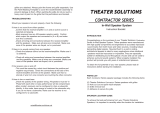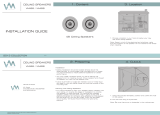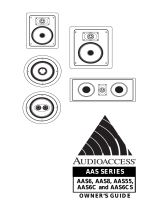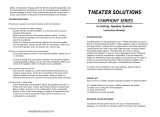7
NEW CONSTRUCTION
PAINTING THE SPEAKER
FRAME AND GRILLE
JBL HTI Series loudspeakers
can be painted to match any
decor. If you wish to change
their color, the satin finish on the
grille and frame will function as
a primer coat. Before painting,
install the paint shield (in the
assembly kit) securely into the
recess in the baffle. This will
protect the speaker components
and baffle from paint residue.
Use a high-quality spray paint,
and apply a thin coat of color.
Be certain the grille
perforations remain
free of paint. Filling
them with paint will
diminish the sound
quality.
Note:
Gently remove the
acoustical foam blanket from the
grille before painting. Reattach
the blanket after the paint has
dried.
You will need to purchase the correct rough-in frame kit for your model:
Speaker Model Rough-in Frame Kit
HTI6 RIF6
HTI8 RIF8
HTI55 RIF55
HTI6C RIF6C
Detailed installation instructions are supplied with the rough-in kit.
TROUBLESHOOTING
If there is no sound
from any of the
speakers:
• Check that receiver/amplifier
is on and a source is playing.
• Check all wires and connections
between receiver/amplifier and
speakers. Make sure all wires
are connected. Make sure none
of the speaker wires are frayed,
cut or punctured.
• Review proper operation of
your receiver/amplifier.
If there is no sound
coming from one
speaker:
• Check the “Balance” control
on your receiver/amplifier.
• Check all wires and connec-
tions between receiver/amplifier
and speakers. Make sure all
wires are connected. Make sure
none of the speaker wires
are frayed, cut or punctured.
In multichannel applications,
make sure that your receiver or
processor has been configured
to enable all channels that you
are using.
If there is low (or no)
bass output:
• Make sure the connections
to the left and right “Speaker
Inputs” have the correct polarity
(+ and –).
• Consider adding a powered
subwoofer to your system.
• In Dolby Digital or DTSmodes,
make sure your receiver/proces-
sor is correctly configured. When
using a subwoofer, make sure
the subwoofer output of the
receiver/processor has been
enabled. If no subwoofer is
being used, make sure the
left and right front and rear
speakers have been config-
ured as “LARGE.” See your
receiver/processor’s owner’s
manual for futher information on
correct speaker configuration in
Dolby Digital, DTS and other
surround-sound modes.
If the system plays at
low volumes but shuts
off as volume is
increased:
• Check all wires and connec-
tions between receiver/amplifier
and speakers. Make sure all
wires are connected. Make sure
none of the speaker wires are
frayed, cut or punctured.
• If more than one pair of main
speakers is being used, check the
minimum-impedance require-
ments of your receiver/amplifier.











